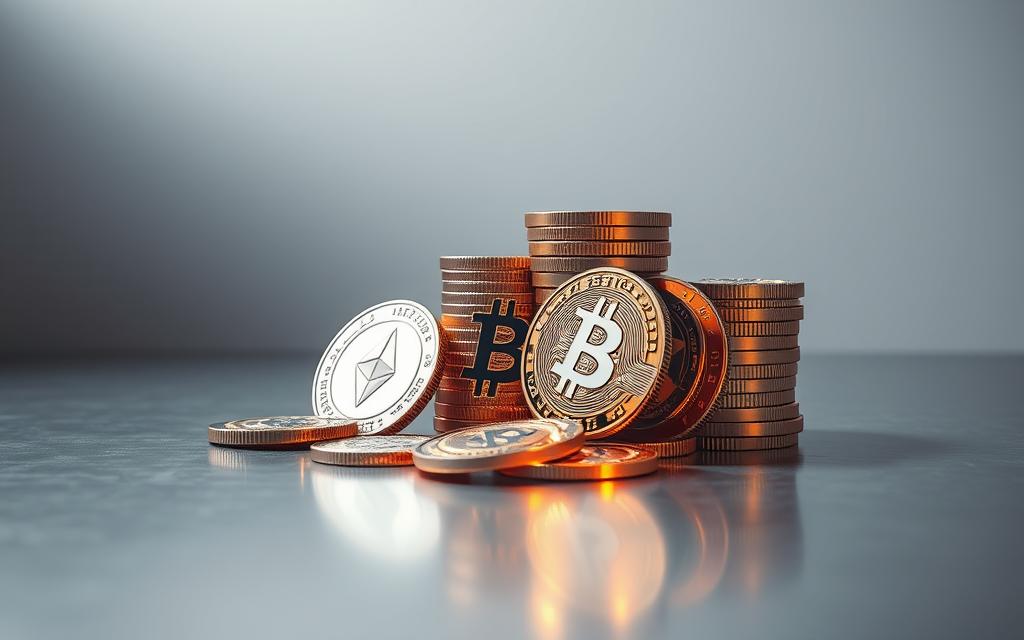Table of Contents
Digital assets like Bitcoin and Ethereum have sparked debates about their role in finance. While many use them for transactions, governments and institutions view them differently. The IRS, for example, classifies these digital assets as property rather than currency.
Some features align with traditional money. They act as a medium of exchange, allowing peer-to-peer transfers without banks. Yet, key differences exist. Unlike fiat currency, they lack centralized control and legal tender status.
El Salvador made history by adopting Bitcoin as official money, but most nations remain cautious. Volatility and regulatory uncertainty keep the debate alive. The $2.4 trillion market cap shows growing interest, but questions persist.
Can decentralized digital assets replace cash? The answer depends on adoption, stability, and legal recognition.
Is Cryptocurrency Considered Money?
Traditional currency serves three main purposes: a medium of exchange, a store of value, and a unit of account. Governments back it as legal tender, ensuring widespread acceptance. Digital assets, however, operate differently.
Core Differences Between Money and Digital Assets
Fiat currency relies on central banks for stability. Digital alternatives like Bitcoin depend on decentralized networks. This affects trust and adoption.
Key contrasts include:
- Legal status: Cash is mandatory for debt settlements; crypto remains optional.
- Volatility: The U.S. dollar fluctuates modestly compared to Bitcoin’s 30-day swings.
- Control: Federal Reserve policies adjust money supply, while crypto algorithms cap total coins.
Peer-to-Peer Exchange Mechanisms
Blockchain technology enables direct transactions without intermediaries. Users transfer digital assets globally in minutes. Traditional bank transfers often take days.
| Feature | Traditional Money | Digital Assets |
|---|---|---|
| Settlement Time | 1-3 business days | 10 minutes – 1 hour |
| Transaction Fees | $15-$50 (wire transfers) | $1-$30 (network dependent) |
| Global Accessibility | Limited by banking infrastructure | Internet connection required |
Adoption grows as platforms like PayPal integrate crypto payments. Over 15,000 businesses worldwide now accept Bitcoin for services.
Energy consumption remains a hurdle. Bitcoin mining uses 91 terawatt-hours annually—more than Finland’s total usage. Innovations like proof-of-stake aim to reduce this footprint.
What Is Cryptocurrency?
Distributed ledgers ensure transparency in every transaction. These digital assets rely on blockchain technology, a cryptographically secured system that records data across multiple nodes. Unlike traditional banking, no central authority controls the network.
Blockchain Technology and Decentralization
A blockchain consists of blocks chained together. Each block stores transaction details, timestamps, and a unique hash. Nodes validate new blocks through consensus mechanisms:
- Proof-of-Work (PoW): Miners solve complex puzzles to add blocks. Energy-intensive but highly secure.
- Proof-of-Stake (PoS): Validators stake coins to approve transactions. Faster and eco-friendly.
| Feature | Proof-of-Work | Proof-of-Stake |
|---|---|---|
| Energy Use | High (91 TWh/year) | Low (~0.01% of PoW) |
| Speed | ~10 minutes/block | ~5 seconds/block |
| Security | Hash power | Staked collateral |
Public-private key pairs encrypt transactions. Hashing ensures immutability—once recorded, data cannot be altered. JPMorgan uses this for instant payments, processing 4,568 Bitcoin blocks monthly.
Key Features of Cryptocurrencies
Virtual currencies share distinct traits:
- Limited supply: Bitcoin caps at 21 million coins.
- Divisibility: 1 BTC = 100 million satoshis.
- Portability: Transferable via internet globally.
Decentralization reduces reliance on banks but raises concerns. Mining pools control 65% of Bitcoin’s hash rate, risking centralization. Yet, the distributed ledger model remains revolutionary.
Legal Status of Cryptocurrency in the United States
U.S. regulators continue shaping the legal landscape for digital assets. Federal agencies classify them differently than traditional currencies, creating complex compliance requirements. Investors and businesses must navigate IRS rules, SEC enforcement, and FinCEN reporting.

IRS Classification: Property, Not Currency
The IRS labels digital assets as *property* under Notice 2014-21. This means:
- Capital gains apply: Selling at a profit triggers tax obligations. Report *losses* to offset income.
- Form 8949 required: Detail transactions by *account* and holding period.
- Mining taxed as income: Fair market value at receipt counts toward earnings.
A July 2023 court ruling clarified distinctions between institutional and retail purchases. This impacts how *exchanges* report user activity.
Regulatory Oversight by the SEC and FinCEN
The SEC targets unregistered securities offerings and non-compliant *exchanges*. Recent actions include:
- Fines for platforms selling tokens without proper disclosures.
- Mandates for institutional-grade custody solutions.
FinCEN enforces the Travel Rule, requiring *exchanges* to share sender/receiver data for transfers over $3,000. States like New York demand BitLicenses, adding layers to *regulatory* compliance.
| Agency | Focus Area | Key Requirement |
|---|---|---|
| IRS | Taxation | Report *property* transactions annually |
| SEC | Investor Protection | Register securities or qualify for exemptions |
| FinCEN | AML/KYC | Verify identities and track suspicious activity |
Federal rulings often conflict with state laws. Wyoming grants *property* rights to digital asset holders, while Texas bans anonymous transactions. This patchwork complicates nationwide operations.
How Cryptocurrencies Are Taxed
Tax rules for digital assets continue evolving as regulators refine policies. The IRS treats these transactions as property, requiring detailed records and specific forms. Failure to report accurately may trigger audits or penalties.
Capital Gains and Reporting Requirements
Selling digital assets for profit incurs capital gains tax. Short-term holdings (under 1 year) use ordinary income rates, while long-term gains benefit from lower brackets. Key steps include:
- Calculate cost basis: Original purchase price plus fees.
- Track sales dates: Determines short-term vs. long-term status.
- File Form 8949: Lists each transaction’s details for IRS review.
Losses can offset up to $3,000 in annual income. Example: A $10,000 Bitcoin sale after 2 years at a $2,000 profit incurs a 15% federal tax ($300).
Tax Implications for Mining and Staking
Rewards from mining or staking count as taxable income at fair market value when received. The 2023 IRS ruling clarified that stakers must report earnings annually, even if tokens remain locked.
“Revenue Ruling 2023-14” mandates income recognition upon token receipt, not sale.
Self-employment tax may apply to mining revenue. Deduct expenses like hardware and electricity to reduce liabilities. Charitable donations over $5,000 require certified appraisals.
| Activity | Tax Treatment | Reporting Form |
|---|---|---|
| Trading | Capital gains/losses | Form 8949 + Schedule D |
| Mining | Ordinary income | Schedule C (if self-employed) |
| Donations | Fair market value deduction | Form 8283 (over $500) |
The IRS offers penalty relief programs for past filing errors. Voluntary disclosures help avoid criminal charges for unreported sales.
Types of Cryptocurrencies
The digital asset landscape features diverse options, each serving unique purposes. From store-of-value tokens to programmable contracts, these assets vary in design and utility. Below, we explore major categories shaping the *market*.

Bitcoin and Ethereum: The Most Popular Options
Bitcoin remains the dominant player, claiming over 50% of the total *market* cap. Its narrative revolves around scarcity—capped at 21 million *units*—and decentralized peer-to-peer transfers. Unlike traditional assets, it bypasses intermediaries.
Ethereum extends functionality with smart contracts. Developers build apps on its *platform*, enabling automated agreements. While Bitcoin focuses on value storage, Ethereum powers decentralized finance (DeFi) ecosystems.
Stablecoins and Utility Tokens
Stablecoins minimize volatility by pegging value to external assets. Two primary types exist:
- Fiat-collateralized: Backed 1:1 by reserves (e.g., USDC).
- Algorithmic: Use smart contracts to balance supply/demand.
Utility tokens grant access to services. XRP facilitates cross-border bank transfers, while Solana’s token covers transaction fees. These differ from security tokens, which represent ownership stakes.
| Asset | Type | Key Feature | Market Rank |
|---|---|---|---|
| Bitcoin (BTC) | Store-of-value | 21M cap | #1 |
| Ethereum (ETH) | Smart contract *platform* | DeFi integration | #2 |
| Tether (USDT) | Stablecoin | Fiat-backed | #3 |
| Solana (SOL) | Utility token | High-speed transactions | #7 |
Wrapped tokens (e.g., Wrapped Bitcoin) enable cross-chain interoperability, bridging networks like Ethereum and Binance Smart Chain. Meanwhile, central bank digital currencies (CBDCs) emerge as government-backed alternatives.
Advantages of Using Cryptocurrency
Peer-to-peer digital transactions eliminate many pain points of conventional banking. These systems provide faster settlements, lower fees, and global access without intermediaries. Users gain unprecedented control over their assets while participating in innovative financial ecosystems.

Faster and Cheaper Cross-Border Transactions
International transfers through traditional banks average 3-5 business days with fees up to $50. Blockchain networks complete similar transactions in minutes for a fraction of the cost. Remittance savings reach 80% compared to services like Western Union.
Key benefits include:
- 24/7 availability: No holiday closures or banking hours
- Microtransaction support: Send values as small as $0.01
- Transparent tracking: Public ledgers verify settlement times
| Method | Average Fee | Processing Time | Success Rate |
|---|---|---|---|
| Bank Wire | $25-$45 | 2-5 days | 97% |
| Credit Card | 3% + $0.30 | 1-3 days | 92% |
| Bitcoin | $1.50-$5 | 10-60 minutes | 99.9% |
Decentralization and Financial Independence
Non-custodial wallets let users control private keys instead of relying on exchanges. This eliminates:
- Account freezes by third parties
- Arbitrary withdrawal limits
- Inflation risks from monetary policies
DeFi platforms generate interest through yield farming, often offering 5-20% APY. Flash loans demonstrate advanced capabilities, settling multimillion-dollar transactions in seconds without collateral.
“Decentralized networks return financial sovereignty to individuals while creating new economic opportunities.”
For example, Venezuelans use digital assets to preserve wealth amid hyperinflation. The 2021 Bitcoin price peak at $65,000 showcased its potential as an inflation hedge.
Disadvantages and Risks of Cryptocurrency
Digital currencies bring innovation but carry significant risks. Price swings, security breaches, and regulatory gaps challenge widespread adoption. Understanding these pitfalls helps users make informed decisions.

Price Volatility and Market Manipulation
Unlike stable fiat currencies, digital assets experience extreme fluctuations. Bitcoin’s value dropped 99% during past crashes, while altcoins often vanish entirely. Traditional stocks rarely see such losses.
Key factors driving volatility:
- Low liquidity: Smaller market caps amplify price swings.
- Whale activity: Large holders manipulate prices via coordinated trades.
- News sensitivity: Regulatory tweets can trigger 20% daily drops.
| Asset | 30-Day Volatility | S&P 500 Comparison |
|---|---|---|
| Bitcoin | 60% | 15% |
| Ethereum | 75% | 15% |
| Stablecoins | 1% | N/A |
Security Risks: Hacks and Lost Keys
Decentralization shifts responsibility to users. Over 20% of Bitcoin remains inaccessible due to misplaced wallet keys. The $600M Poly Network hack highlights smart contract vulnerabilities.
Common threats include:
- Phishing scams: Fake exchanges steal login credentials.
- Exchange collapses: FTX’s 2022 bankruptcy froze $8B in assets.
- Cold vs. hot storage: Offline wallets reduce hack risks but complicate access.
“Self-custody demands technical literacy. One error can erase lifelong savings.”
Regulatory uncertainty compounds these issues. Governments may ban transactions or impose restrictive policies, impacting market stability. Always research before committing funds.
Cryptocurrency as an Investment
Financial markets have evolved to include digital asset investment products. These alternatives serve diverse purposes, from hedging against inflation to capturing high-growth opportunities. Unlike traditional securities, they operate 24/7 with unique risk-reward profiles.
Speculative Nature and Long-Term Viability
Digital assets exhibit extreme price swings compared to conventional investment vehicles. Bitcoin plunged to $20,000 in 2022 before rebounding, demonstrating both risk and potential. Historical data shows:
- 5-year ROI: Bitcoin +1,200% vs S&P 500 +85%
- Volatility: 3x higher than tech stocks
- Correlation: 0.38 with gold during crises
Experts recommend limiting exposure to 1-5% of portfolios. Cold storage wallets provide security for long-term holders. The market value often moves independently of traditional assets, offering diversification benefits.
Spot Bitcoin ETFs and Other Investment Vehicles
The SEC approved spot Bitcoin ETFs in 2024, creating regulated access points. These products differ from futures-based ETFs by holding actual assets. Key comparisons:
| Type | Pros | Cons |
|---|---|---|
| Direct Ownership | Full control | Custody risks |
| Spot ETF | Tax-advantaged accounts | Management fees |
| Futures | Liquidity | Contango costs |
“Institutional adoption accelerated after ETF approvals, with Schwab reporting $4B inflows in Q1 2024.”
Custodial solutions like Coinbase Institutional now manage $130B in assets. Meanwhile, decentralized platforms enable non-custodial trading through smart contracts. Each approach suits different risk tolerances and market value objectives.
Practical Uses of Cryptocurrency
From coffee shops to nonprofits, blockchain-based payments reshape commercial interactions. Over 15,000 merchants now accept digital assets for goods and services, while charities use them for transparent fundraising. These applications move beyond speculation into tangible economic utility.
Purchasing Goods and Services
Business adoption spans industries and continents. Major hotspots include Miami, Berlin, and Singapore, where crypto-friendly regulations encourage integration. Common use cases:
- E-commerce platforms: Shopify merchants process $2.4B annually in crypto payments
- Travel bookings: Travala.com accepts 50+ tokens for hotel stays
- NFT ticketing: Event organizers issue verifiable digital passes
Micropayments enable new models. Content creators earn fractions of cents per view, while gaming platforms trade in-game units seamlessly. Starbucks tests blockchain rewards, converting loyalty points to tokens.
Remittances and Charitable Donations
Cross-border transfers benefit from lower fees and faster settlement. Migrant workers save 80% compared to traditional remittance services. Notable examples:
- Ukraine relief: $100M+ raised via Ethereum and Polkadot wallets
- Disaster response: Red Cross accepts Bitcoin for rapid fund deployment
- Payroll solutions: Remote teams receive salaries in stablecoins
“IRS Publication 526 allows deductions for crypto donations at fair market value if held over 12 months.”
| Use Case | Advantage | Example |
|---|---|---|
| Charitable Giving | Transparent tracking | Binance Charity’s auditable wallets |
| Cross-Border Pay | 24/7 availability | Bitwage’s international payroll |
| Microtransactions | Fractional units | Brave Browser’s BAT rewards |
Compliance requirements vary by jurisdiction. The U.S. mandates Form 8283 for donations over $500, while the EU exempts small transfers from reporting. Always verify local rules before transacting.
Conclusion
Regulators and investors grapple with crypto’s dual identity as both money and property. Recent IRS rulings and SEC actions highlight evolving frameworks for digital assets, while spot ETFs broaden institutional access.
Security remains critical—use hardware wallets for large holdings and verify transactions. Over 15,000 merchants now accept payments, signaling steady adoption despite volatility.
Consult a tax professional to navigate reporting rules. As blockchain bridges gaps in traditional currency systems, its role in global finance will keep expanding.
FAQ
Does the IRS classify digital assets as real money?
No. The IRS treats virtual currencies like Bitcoin as property, not legal tender. This means transactions are subject to capital gains tax rules.
Can you buy goods and services with distributed ledger assets?
Yes. Many merchants accept payments in Bitcoin, Ethereum, and stablecoins. Platforms like PayPal and Shopify support these transactions.
What makes blockchain-based tokens different from traditional currency?
Unlike dollars, virtual currencies operate without central banks. They rely on decentralized networks and cryptographic security for verification.
Are trading losses on exchanges tax-deductible?
Yes. If you sell digital assets at a loss, you can report it to offset gains. Proper documentation from platforms like Coinbase is required.
How does staking work for tax purposes?
Rewards from staking are taxable as income at their market value when received. Later sales may trigger additional capital gains taxes.
Why do stablecoins minimize volatility risks?
Stablecoins like USDT are pegged to fiat currencies. This reduces price swings compared to speculative assets such as Bitcoin.
What security risks come with self-custody wallets?
Losing private keys means permanent loss of funds. Hardware wallets like Ledger provide safer storage than online exchanges.
Do spot Bitcoin ETFs simplify investing?
Yes. Funds like BlackRock’s IBIT let investors gain exposure without managing private keys or navigating exchanges directly.
Are remittances cheaper using virtual currencies?
Often. Sending funds via Ripple or Litecoin can bypass high fees charged by traditional remittance services like Western Union.
Can donations in crypto qualify for tax deductions?
Yes. Charities like the Red Cross accept digital assets, and donors may avoid capital gains while claiming deductions.









